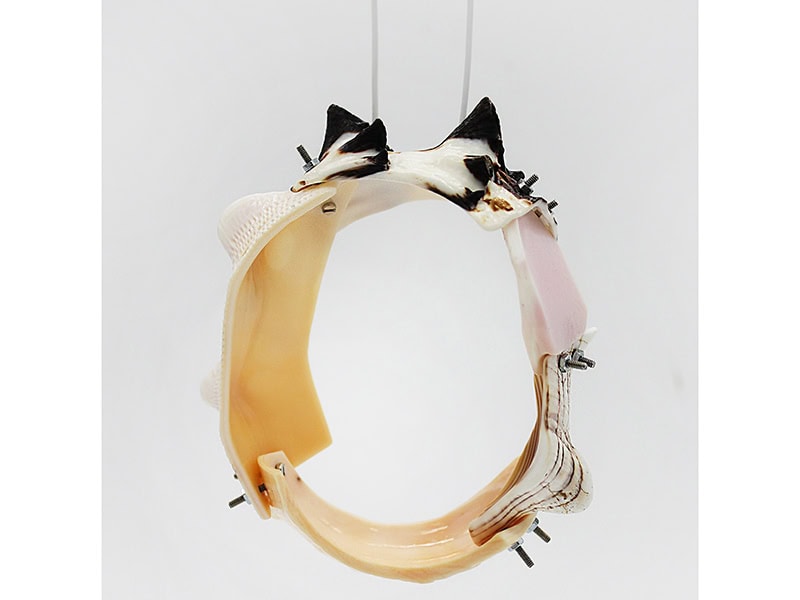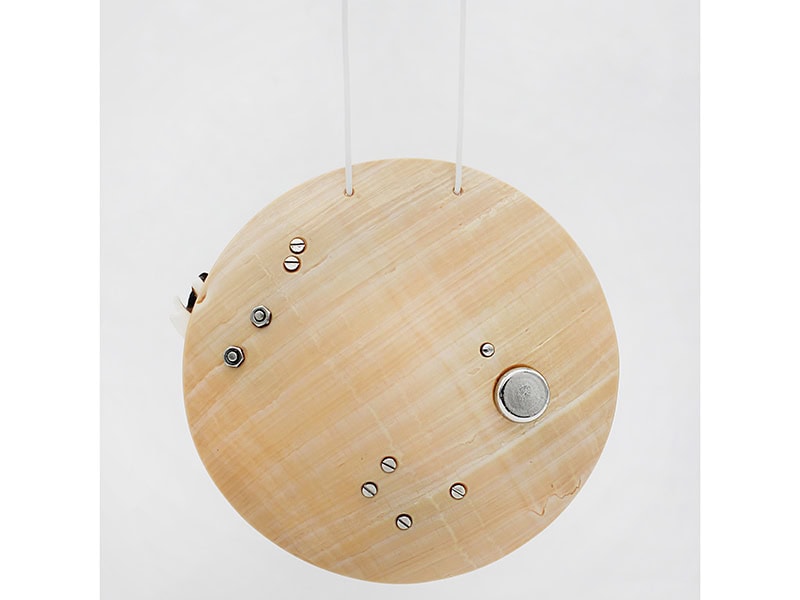AJF’s Young Artist Award acknowledges promise, innovation, and individuality, advancing the careers of rising artists. The work of the winner and four finalists represents a group of outstanding pieces of contemporary jewelry. As a finalist, Goutos received an unrestricted cash award of US$1,000 and exhibited her work in Platina’s booth during Munich’s jewelry week.
AJF asked this year’s honorees to describe their backgrounds and share their thoughts on the future of our field. This is the third of our interviews. Read the one with Bryan Parnham here. Our interview with Margo Csipö is here. Aaron Decker answered our questions here, and you can read the interview with Everett Hoffman here. Also, watch AJF Live with Bryan Parnham here.
The competition was open to makers of wearable art age 35 and under who are not currently enrolled in a professional training program. Judging was based on originality, depth of concept, and quality of craftsmanship. This year’s jurors were 2022 AJF Artist Award winner Mallory Weston (from the US); collector and gallerist Atty Tantivit (Thailand); and maker Ted Noten (Netherlands). Stay tuned for interviews with the other finalists over the coming months.

AJF: Congratulations on being a finalist for the Young Artist Award competition, Corrina—that’s quite an accomplishment! How did you become interested in jewelry? And what inspires your work?
Corrina Goutos: Much gratitude again to AJF and the jury for selecting my work.
Before I had the words to describe it, I was fascinated by how select objects achieve super-charged status. Everyday things get tasked with placeholding significant human experience, and are thereby enabled to transcend their market values. The chance to foster this bond between humans and nonhumans drew me to jewelry over other art forms nearly 20 years ago.
I love to work with universally recognizable objects to conjure up associations in the viewer’s mind, only to quickly betray them, revealing the objects themselves as lively agents entangled in our capitalist schemes and sentimental tendencies. I am most excited about documenting and reproducing ambiguous objects. Ones that don’t fit tidily into the supposed dichotomy of nature and industry. Objects in transition.

AJF: What does being a finalist mean for you? Do you think it will influence you going forward?
Corrina Goutos: It’s great when work arrives. Working interdisciplinarily, somewhere between applied and fine arts (how quickly we stumble on more outdated binaries), has its drawbacks. You get used to being “too this for them” and “too this for them.” So being an AJF finalist for the second time[1] assures me that the work has a place in contemporary jewelry. By holding that space, maybe I also make space in the field for other outliers.
In this regard, I can take my foot off the brake, as I continually grow my understanding of the extended body. Some punctuated positive feedback is enough to say “we are on track, onto something.”
AJF: Tell us about the work you applied with.
Corrina Goutos: My series Vestigial Trait Bait explores the feeling of estrangement from having lost our attunement with, and awe for, nature. When working with the large shell specimens, I neglected to accentuate the natural beauty of the form but rather colonized it with stubborn intent. For this, I researched techniques that exemplify mankind’s imposition onto nature, adding connection methods from ancient tree-grafting and modern surgical interventions to my repertoire of metalsmithing connections.
In an unapologetic manner, anatomical traits are pasted together with an industrial logic, resulting in a Frankensteinian composition that is one-part spandrels and vestigial traits of evolutionary biology and one-part AI image generator.
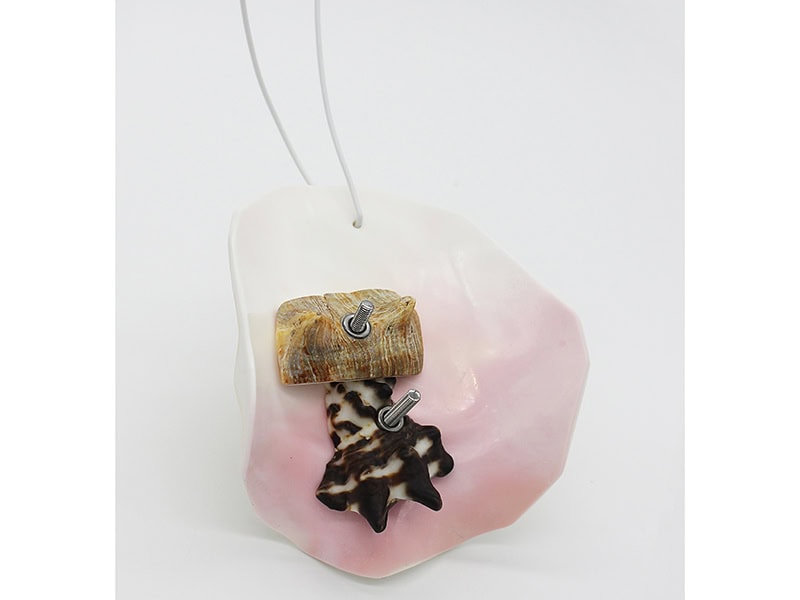
AJF: Tell us about Vestigial Trait Bait 2.
Corrina Goutos: With this piece, I resisted the urge to get precious particularly well. The backdrop is a circle from a deliciously pink conch shell I could hardly bear to cut. Instead of planning the cut meticulously to best frame its features, I grabbed a side-cutter (one which I struggle to command, given my hand size) and jabbed out an irregular circle. As I softened the shape, I found it needed horns to balance its silky pink flesh. I found two such cuties on a nearby shell and prepared the transplant. Perusing a fave collection of small shells elements (largely consisting of “scraps”—a.k.a. cut-outs from past pieces), I tried elements on one by one. The brown and white shell I ultimately chose to complete this was a donated beach find from an eager fan, who will perhaps smile seeing it recontextualized here.
I then swirled the elements around on the concave base piece until they rested somewhere naturally. I photographed it and repeated this several times, later choosing the strongest composition. I alter the elements minimally to sit perfectly in their final position. This way I can claim nature and entropy as my true collaborators. The connections represent the human touch—so I wanted them to be as pragmatic as possible. With only two rods and threaded dowels, I pinned the features. I applied them as a surgeon would stabilize a break, precise, yet perfect in their asymmetry.
The completed piece has a certain immediacy about it—a trait I both love and envy in the art of others. Additionally, here my qualms about girlhood and the color pink are laid to rest, replaced by a tantalizing tension between polarities of gender, soft/hard, gentle/violent. I found myself referring to it as a type of contemporary fertility figure—disembodied breasts and a skirt pinned onto a pink backdrop by rather assuming phallic bolts.
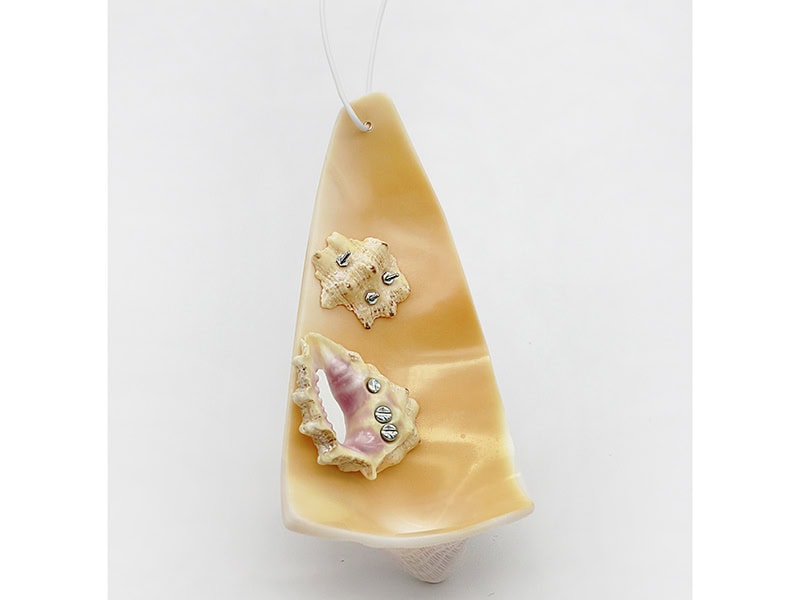
AJF: What excites you about the art jewelry field?
Corrina Goutos: Our love of oddities! Forging them, collecting them, and, of course, producing them. We have a lot of empathy and understanding for oblique objects. The care and intention we give them can ground us, give us purpose, and even satisfy a need for belonging and stability in a rapidly changing world. This effect of thing-solidarity seems to be especially strong in those who have experienced displacement—socially or physically—which I’ve observed to be rather commonplace amongst jewelers. As one such person, I find it refreshingly easy to connect with makers who share my empathy for downtrodden things.

AJF: Where do you think the field is going? What new and exciting trends do you see in art jewelry?
Corrina Goutos: My ears perk up as questions of whether “digital fabrication is disembodied and therefore not real craftsmanship” begin to ruminate. I personally am a handcraft person, but am a big proponent of making work that is highly relevant to the times. In that regard, this is just the tip of the digital fabrication iceberg. I stay tuned to Darja Popolitova as she straightens out misconceptions about crafting with computers, touching on where in history we started to separate mind and body and how truly paradoxical such an ideology is today.
AJF: Any frustrations that you have with the field or see within it?
Corrina Goutos: Sure. There are sadly not enough people in regarded positions willing to call the next generation of jewelers into their rightful position. I observe gallerists and juries (ones that aren’t blind, the way AJF is) tending to err on the safe side, sticking with big names and favoring colleagues. Not only does this get redundant, but it is also a shame to see talented young artists investing 10–15 years or more before they have any place in the field. (Many don’t make it that long.) If gallerists aren’t scouting out truly time-relevant work and priming collectors and the public for it, the field risks aging out.
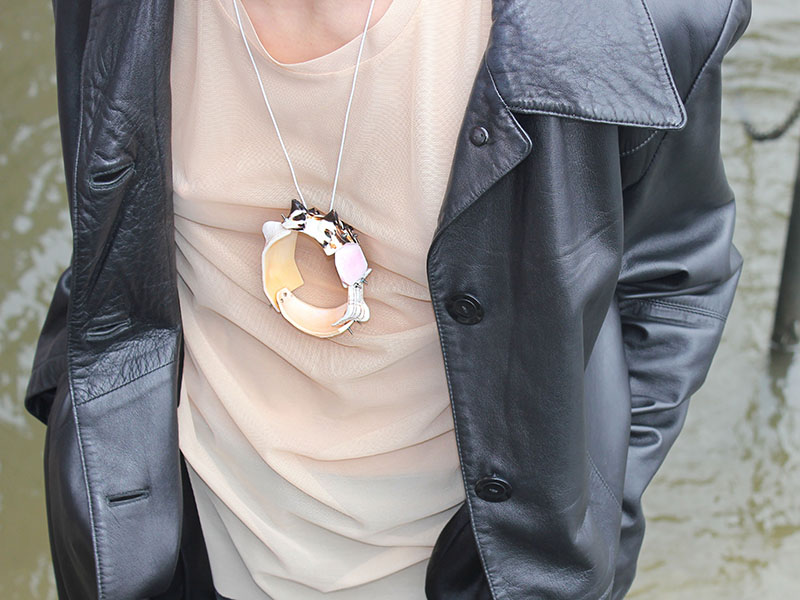
AJF: If you could write a master plan for your practice, where would you like to be five years from now?
Corrina Goutos: I would like to have refined my maker’s philosophy of Anthrosmithing, which entails knowing the properties of the ready-made object just as a goldsmith knows gold. I hope to be offering workshops that help makers deconstruct colonial relations with nature, and think more in harmony with her processes. By removing vocabulary such as “raw material” and “master,” I hope to get back to the core of craftsmanship—a bond between humans and nonhumans achieved by listening to, thinking with, and eventually, fluently speaking materiality.
Congratulations again! Thank you for taking the time to tell us about you and your practice.
Corrina Goutos: Thank you so much for your time and attention.
Several of Corrina Goutos’s works are currently on view in Lisbon as part of the biennial. You can see them there until September 22, 2024. Purchase her work via her website’s contact form, or directly from her souvenir shop. Check it out, it’s a fun visual ride!
[1] Goutos was a finalist for the 2018 Artist Award. See her work and learn more about it here.
We welcome your comments on our publishing, and will publish letters that engage with our articles in a thoughtful and polite manner. Please submit letters to the editor electronically; do so here.
© 2024 Art Jewelry Forum. All rights reserved. Content may not be reproduced in whole or in part without permission. For reprint permission, contact info (at) artjewelryforum (dot) org

